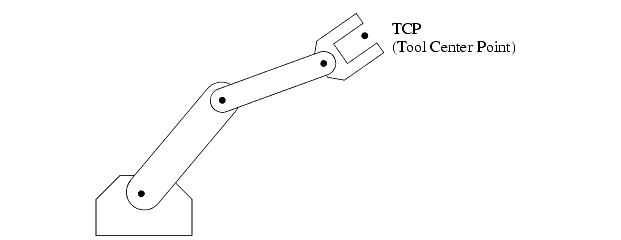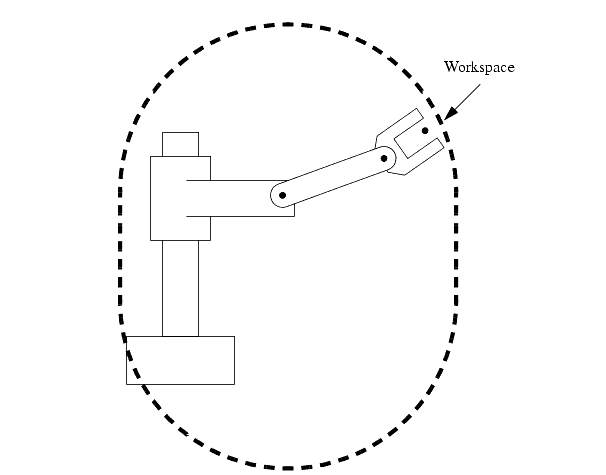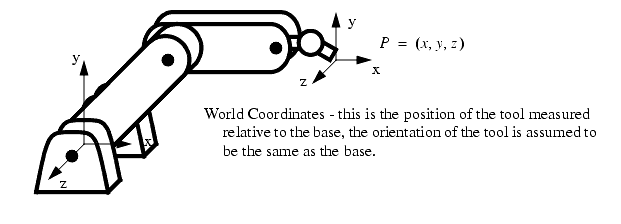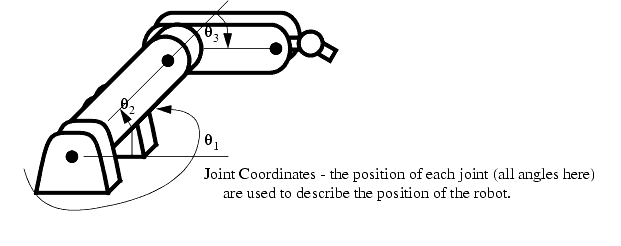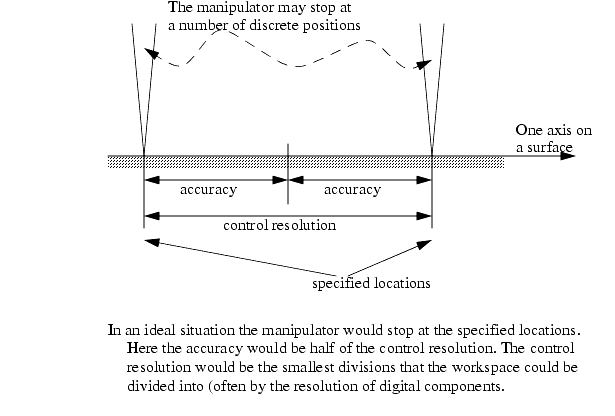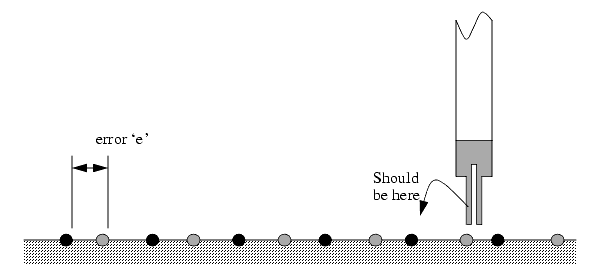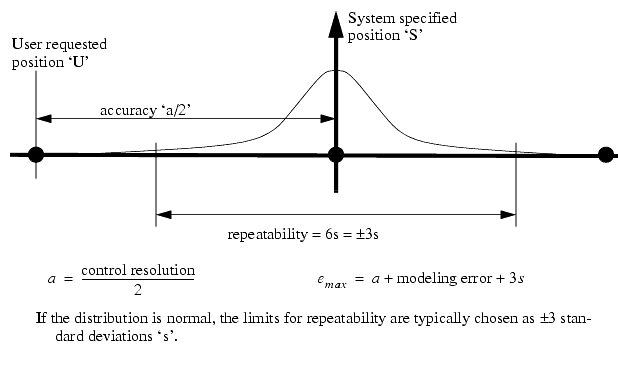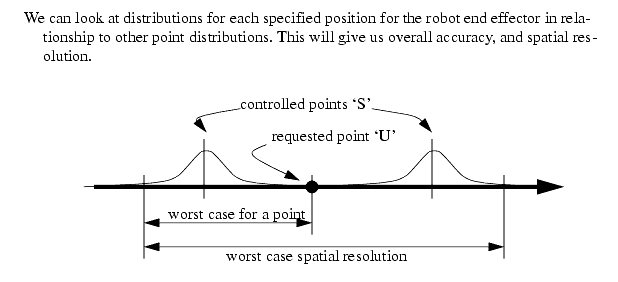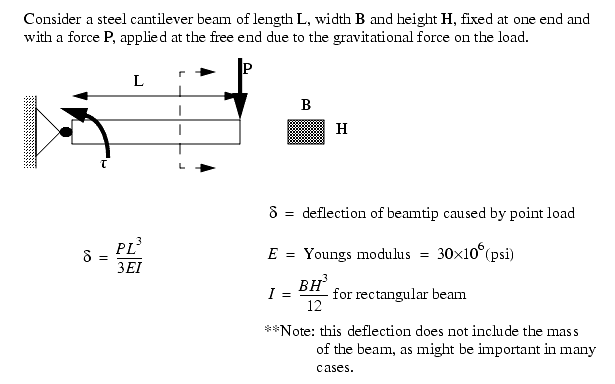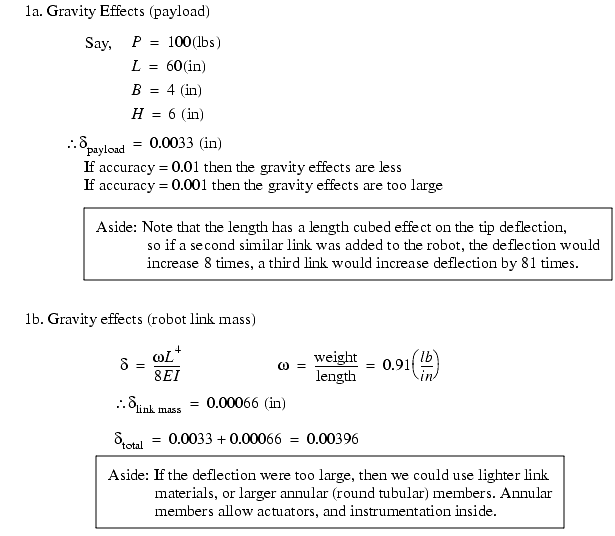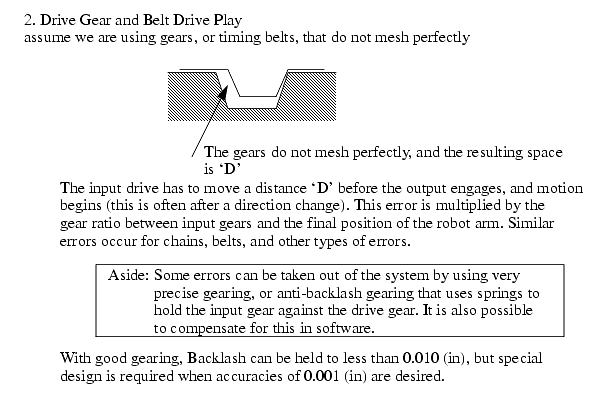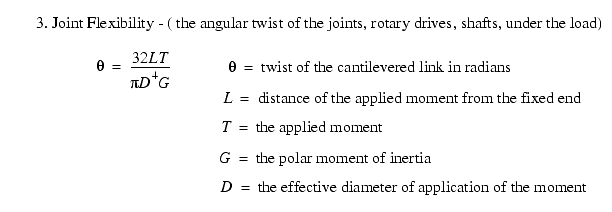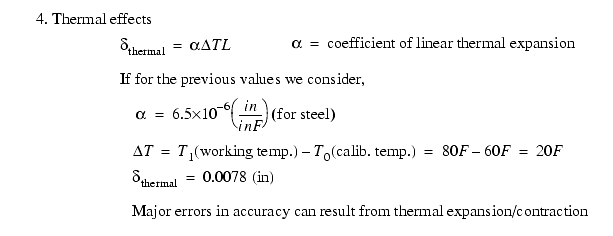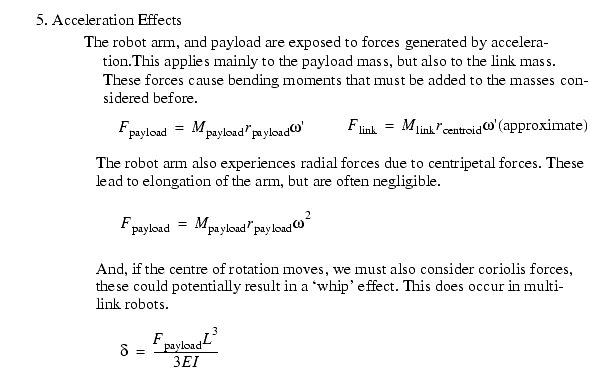14.1 INTRODUCTION
������������
Robots are devices that are programmed to move parts, or to do work with a tool. For example, robots are often used to stack boxes on a pallet, or to weld steel plates together. This chapter will introduce the basic concepts behind robotics, and introduce a commercial robot. Following chapters will introduce more robots, and discuss applications.
14.1.1 Basic Terms
������������
There is a set of basic terminology and concepts common to all robots. These terms follow with brief explanations of each.
Links and Joints - Links are the solid structural members of a robot, and joints are the movable couplings between them.
Degree of Freedom (dof) - Each joint on the robot introduces a degree of freedom. Each dof can be a slider, rotary, or other type of actuator. Robots typically have 5 or 6 degrees of freedom. 3 of the degrees of freedom allow positioning in 3D space, while the other 2or 3 are used for orientation of the end effector. 6 degrees of freedom are enough to allow the robot to reach all positions and orientations in 3D space. 5 dof requires a restriction to 2D space, or else it limits orientations. 5 dof robots are commonly used for handling tools such as arc welders.
Orientation Axes - Basically, if the tool is held at a fixed position, the orientation determines which direction it can be pointed in. Roll, pitch and yaw are the common orientation axes used. Looking at the figure below it will be obvious that the tool can be positioned at any orientation in space. (imagine sitting in a plane. If the plane rolls you will turn upside down. The pitch changes for takeoff and landing and when flying in a crosswind the plane will yaw.)
Figure 7.1 - Orientations
Position Axes - The tool, regardless of orientation, can be moved to a number of positions in space. Various robot geometries are suited to different work geometries. (more later)
Tool Centre Point (TCP) - The tool centre point is located either on the robot, or the tool. Typically the TCP is used when referring to the robots position, as well as the focal point of the tool. (e.g. the TCP could be at the tip of a welding torch) The TCP can be specified in cartesian, cylindrical, spherical, etc. coordinates depending on the robot. As tools are changed we will often reprogram the robot for the TCP.
Figure 7.2 - The Tool Center Point (TCP)
Work envelope/Workspace - The robot tends to have a fixed, and limited geometry. The work envelope is the boundary of positions in space that the robot can reach. For a cartesian robot (like an overhead crane) the workspace might be a square, for more sophisticated robots the workspace might be a shape that looks like a `clump of intersecting bubbles'.
Speed - refers either to the maximum velocity that is achievable by the TCP, or by individual joints. This number is not accurate in most robots, and will vary over the workspace as the geometry of the robot changes (and hence the dynamic effects). The number will often reflect the maximum safest speed possible. Some robots allow the maximum rated speed (100%) to be passed, but it should be done with great care.
Payload - The payload indicates the maximum mass the robot can lift before either failure of the robots, or dramatic loss of accuracy. It is possible to exceed the maximum payload, and still have the robot operate, but this is not advised. When the robot is accelerating fast, the payload should be less than the maximum mass. This is affected by the ability to firmly grip the part, as well as the robot structure, and the actuators. The end of arm tooling should be considered part of the payload.
Repeatability - The robot mechanism will have some natural variance in it. This means that when the robot is repeatedly instructed to return to the same point, it will not always stop at the same position. Repeatability is considered to be +/-3 times the standard deviation of the position, or where 99.5% of all repeatability measurements fall. This figure will vary over the workspace, especially near the boundaries of the workspace, but manufacturers will give a single value in specifications.
Accuracy - This is determined by the resolution of the workspace. If the robot is commanded to travel to a point in space, it will often be off by some amount, the maximum distance should be considered the accuracy. This is an effect of a control system that is not necessarily continuous.
Settling Time - During a movement, the robot moves fast, but as the robot approaches the final position is slows down, and slowly approaches. The settling time is the time required for the robot to be within a given distance from the final position.
Control Resolution - This is the smallest change that can be measured by the feedback sensors, or caused by the actuators, whichever is larger. If a rotary joint has an encoder that measures every 0.01 degree of rotation, and a direct drive servo motor is used to drive the joint, with a resolution of 0.5 degrees, then the control resolution is about 0.5 degrees (the worst case can be 0.5+0.01).
Coordinates - The robot can move, therefore it is necessary to define positions. Note that coordinates are a combination of both the position of the origin and orientation of the axes.
Figure 7.3 - World Coordinates - To Locate the TCP
Figure 7.4 - Tool Coordinates - Describing Positions Relative to the Tool
Figure 7.5 - Joint Coordinates - the Positions of the Actuators
14.1.2 Positioning Concepts
������������
14.1.2.1 - Accuracy and Repeatability
������������
The accuracy and repeatability are functions of,
- resolution- the use of digital systems, and other factors mean that only a limited number of positions are available. Thus user input coordinates are often adjusted to the nearest discrete position.
- kinematic modeling error - the kinematic model of the robot does not exactly match the robot. As a result the calculations of required joint angles contain a small error.
- calibration errors - The position determined during calibration may be off slightly, resulting in an error in calculated position.
- random errors - problems arise as the robot operates. For example, friction, structural bending, thermal expansion, backlash/slip in transmissions, etc. can cause variations in position.
Accuracy,
"How close does the robot get to the desired point"
This measures the distance between the specified position, and the actual position of the robot end effector.
Accuracy is more important when performing off-line programming, because absolute coordinates are used.
Repeatability
"How close will the robot be to the same position as the same move made before"
A measure of the error or variability when repeatedly reaching for a single position.
This is the result of random errors only
repeatability is often smaller than accuracy.
Resolution is based on a limited number of points that the robot can be commanded to reach for, these are shown here as black dots. These points are typically separated by a millimeter or less, depending on the type of robot. This is further complicated by the fact that the user might ask for a position such as 456.4mm, and the system can only move to the nearest millimeter, 456mm, this is the accuracy error of 0.4mm.
In a perfect mechanical situation the accuracy and control resolution would be determined as below,
Kinematic and calibration errors basically shift the points in the workspace resulting in an error `e'. Typically vendor specifications assume that calibration and modeling errors are zero.
Random errors will prevent the robot from returning to the exact same location each time, and this can be shown with a probability distribution about each point.
The fundamental calculations are,
14.1.2.2 - Control Resolution
������������
Spatial resolution is the smallest increment of movement into which the robot can divide its work volume. Spatial resolution depends on two factors: the systems control resolution and the robots mechanical inaccuracies. It is easiest to conceptualize these factors in terms of a robot with 1 degree of freedom.
Control resolution - is determined by the robot's position control system and its feedback measurement system. It is the controllers ability to divide the total range of movement for the particular joint into individual increments that can be addressed in the controller. The increments are sometimes referred to as "addressable parts". The ability to divide the joint range into increments depends on the bit storage capacity in the control memory. The number of separate, identifiable increments (addressable points) for a particular axis is,
example - A robot with 8 bit control resolution can divide a motion range into 256 discrete positions. The control resolution is about (range of motion)/256. The increments are almost always uniform and equal.
If mechanical inaccuracies are negligible, Accuracy = Control Resolution/2
14.1.2.3 - Payload
������������
The payload is always specified as a maximum value, this can be before failure, or more commonly, before serious performance loss.
Static considerations,
- gravity effects cause downward deflection of the arm and support systems
- drive gears and belts often have noticeable amounts of slack (backlash) that cause positioning errors
- joint play (windup) - when long rotary members are used in a drive system and twist under load
- thermal effects - temperature changes lead to dimensional changes in the manipulator
Dynamic considerations,
- acceleration effects - inertial forces can lead to deflection in structural members. These are normally only problems when a robot is moving very fast, or when a continuous path following is essential. (But, of course, during the design of a robot these factors must be carefully examined)
e.g.

